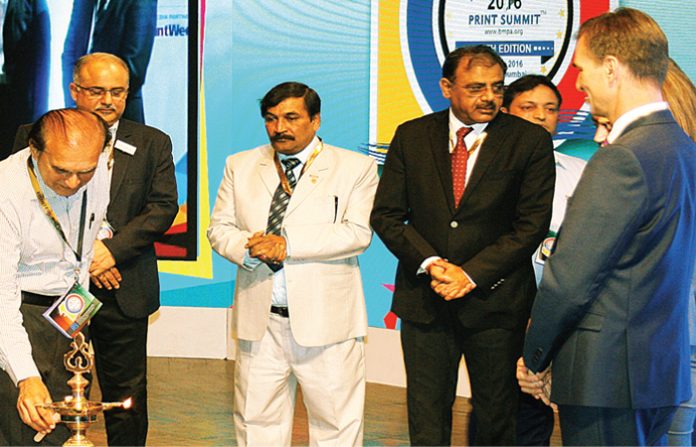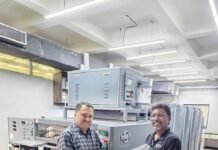The 10th edition of the annual knowledge seminar, Print Summit, organized by Bombay Master Printers’ Association (BMPA) on 29 January attracted more than 900 delegates. The full day event held at NCPA’s Tata Theatre was packed with talks and presentations by leading figures from the printing industry and beyond. The Print Summit platform was also used to formally announce the alliance of BMPA with Mumbai Mudrak Sangh (MMS) by Faheem Agboatwala and Tushar Dhote, respective presidents of BMPA and MMS. Both Agboatwala and Dhote expressed optimism about the move and said that the coming together of the two federations will strengthen and benefit the print industry as there will be better coordination on training and educational programmes as well as on the settlement of grievances. A joint committee comprising members from both BMPA and MMS will look into all these issues. A joint magazine, Mumbai Impressions, was also launched at the event.
Technological disruption
The opening presentation was by Samir Gulve, managing director for India at EFI, on a very relevant topic of how new technologies are disrupting the status quo across industries and the printing industry was not immune to this trend. He said technologies such as internet of things, big data and cloud have brought about massive changes in recent years and added that software will play a very important role in print as well, with the printing press having its own ecosystem. In other words, the press will be cloud connected, data driven and mobility enabled resulting in a higher uptime. “Every business is gradually becoming a software business,” he said while giving the example of Tesla cars which are packed with ground-breaking software.
Along similar lines the printing industry is also witnessing newer technologies. Citing the example of inkjet and the role of software, Gulve said the capability, quality, speed and accuracy of inkjet technology is advancing rapidly. “Inkjet needs to be fed copious amounts of data, especially if you are into variable printing. You need to have processors that are going to continue to feed very high throughput data to it so that overall throughput remains high. So parallel processing is playing a part.” A similar advancement is taking place in ink technology and nano technology, while thinner and stronger substrates are opening new avenues.
Providing a glimpse into what to expect at drupa, Gulve said that some highlights expected at the event would be high speed presses for packaging, interesting inkjet applications for textiles and inkjet presses for B size cut sheets. Software too would be a highlight at drupa with more workflows and end-to-end automation and touchless POD.
A successful family-run business
The keynote address was delivered by Harsh Mariwala, chairman and managing director of Marico. With large number of printing houses being family-run businesses, Mariwala’s talk was apt for the audience as he shared his experiences in building a familyrun business into a multinational professionally run organization. The biggest challenge any family-run business faces is how to tackle the issue of ownership and management. For a business to be successful, talent is needed and in majority of cases that talent needs to be brought in from outside. According to Mariwala, this could create friction between various family members which should be handled by building a consensus. He recalled how during the early growth phase he carved out the oil business from the larger family-owned entity called Bombay Oil Industries. He faced issues but was able to glide through by talking to other family members and building a consensus by putting his point across convincingly. Once you successfully bring in outside talent it is important to motivate the workforce and retain them and gain their trust by building an organizational culture. He touched upon various things Marico does to create a unique culture in the company.
While concluding he said thatin order for a company to keep growing in the long run it hasto innovate and adapt to the latesttechnology. He shared an episode in the company’s historywhen Maricowas able to change the game in the oil business by ushering in a change where tin containerswere gradually replaced by plastic. “Initially therewas a lot of resistance and scepticism butwe were convinced aboutthe idea.Now almostthewhole oil market uses plastic packaging.”
Inkjet – the other messiah
After Samir Gulve of EFI had talked about how inkjet technologies are rapidly advancing, Karin Mayer, vice president, business line management, ink and dry toner solutions, Canon Oce, through her presentation urged printers to adopt the technology calling it the ‘other messiah.’ She furnished some statistics pertaining to development on the digital front in India. In terms of total value in the Indian print market, the share of digital equipment has risen from 20% in 2010 to 32% in 2015 and is expected to rise further to 37% in 2020. On the volumes front, the Indian print market has shown a compound annual growth rate (CAGR) of 2.5%. The CAGR between 2015 to 2020 is expected to be higher at 3.8%. The most noticeable growth is expected to be seen in newspapers, commercial and packaging and labels, she said. Mayer argued that inkjet will fit into the offset workflow because it is geared towards handling larger size paper stock.
Puneet Datta, director, professional printing products division, Canon India, spoke on how digital technology has helped printers grow. Citing a research done by Infotrends, Datta said a significant chunk, more than 50% of printers with digital printing capabilities, attributed growth in revenue and profit to digital. The same research showed that print service providers who grew 10% or more attributed the highest share of revenue (26%) to value added services whereas printers with declining revenues attributed the highest value (41%) to conventional technologies. Printers who did not add the new technology earlier were left behind. “Digital is a very good compliment to offset,” he said, adding that digital can help in exploring new production processes, entering new markets, designing new business models, seeking new opportunities and new revenue streams.
Don’t live in the past
Do not live in the past because the current business environment is very different from what it was 15 to 20 years ago, was a very pertinent message delivered to the delegates at the Print Summit by Mehul Desai, founder and chairman of Mail Order Solutions. During his 30-minute talk which was called ‘30 Mad Minutes’ he reminded printers that the environment we are operating in is in stark contrast to what it was when a lot of people sitting in the audience started their business in late 80s or early 90s.
“We must realize that what we were doing 20 years ago was relevant then. What we want to do today must be relevant to today’s time,” Desai said. To stress his point, he gave examples of Xerox and Uber. Xerox took many decades to reach the current valuation of US$ 10 billion while Uber reached a valuation of US$ 50 billion in just seven years. This happened because the idea of Uber took birth in an environment which was very different from when Xerox was founded. Uber had much easier access to funds.
Desai said that printers have to realize that the way print is consumed is changing and will continue to change, technologies that are used to print will continue to change and the volume that one is used to will change with print runs being very different from what it was before. “We as printers need to be ready to confront these changes. If we are going to run away from all this, it will be difficult for us to remain relevant.”
Komori’s success in India
Sangam Khanna, president and managing director at Insight Communication talked about the success story of Komori in India as well as various products and solutions that the company has to offer to India especially highlighting the Komori GL40 and GLX 40 machine for the packaging industry. In the last decade Komori has managed to have 211 installations across India. In 2014 it became the market leader in India with more than 50% share. According to Khanna this was achieved because Komori is a world-class brand, has a strong local partner, the presses provide great ROI and productivity, strong service and has a large range of solutions.
He also provided a sneak peek into what Komori will be showing at drupa this year. There will be the new digital workflow solution. Moreover, at drupa will be Impermia IS29, the B2 size machine which will be available in UV. Komori in partnership with Landa will inaugurate its much awaited Landa S10 B1 press at drupa 2016.
Philosophical approach to business
In addition to the aforementioned talks, the audience also got to hear a fascinating talk by Iqbal Kherodawala, CEO and chief mentor of Printline Reproductions who extracted management lessons from the epic Mahabharata. Professor VK Murti from SP Jain Institute of Management Studies talked about growth in the family-run business. Justice SC Dharamadhikari of Bombay High Court spoke on ‘Ethics and its relevance in business.’ Swami Sukhabodhananda, founder of Prasanna Trust, talked about how a positive mind is important to have a successful business life.


















